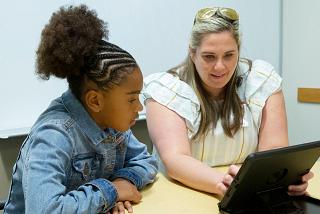Any parent can tell you that it’s a tumultuous time when their children reach the age of 9 or 10. At that point, a child experiences daily physical, emotional, and social changes that signal the approach of adulthood. For the 10 years after, kids also undergo intense brain development that includes rapid cognitive growth and fine-tuning of neural circuits. They start thinking and acting in ways that seem downright grown-up.
To understand how the brain changes and matures during late childhood and adolescence, 21 research centers across the country have enrolled 12,000 children in the Adolescent Brain and Child Development (ABCD) study. The researchers aimed for a sample that reflects the nation’s diversity by recruiting through schools selected according to the students’ gender, race and ethnicity, and socioeconomic status, and the population density where they live. It’s the largest long-term study in the country of physical and behavioral development. With 1,000 participants, HMHI is the leading site.
The findings will help researchers understand how childhood experiences influence brain development and impact behavior later in life.
“Adolescence is a time when we often see the emergence of depression, anxiety, and substance abuse,” says Deborah Yurgelun-Todd, PhD, principal investigator for the study. “With this baseline data, we’ll learn whether brain patterns change in children who develop these problems compared to those who don’t.”
“We now have a very large database we can use to quantify and describe brain function. There’s never been a resource like this available to the scientific community.”
Deborah Yurgelun-Todd, PhD, Vice Chair of Research
Regulating Drives
The ABCD Consortium has collected functional magnetic resonance imaging (fMRI) scans revealing patterns of brain activity in more than 12,000 9-and 10-year-old children. A study reported in Nature Neuroscience used data from 6,000 participants to determine the active parts of the brain when children take part in three cognitive tasks— reward processing, working memory, and inhibitory control.
As children mature, the prefrontal area of the brain helps them self-regulate these executive functions. “There’s evidence that the brain handles these tasks differently in people with mood disorders or who use drugs or alcohol,” says Yurgelun-Todd.
During the same period in a child’s life, basic drives related to reward circuitry may increase desire for food or sex. The relationship between these drives and inhibitory control may be a key to whether children engage in healthy decision making—because those who don’t could be at increased risk of developing disorders like depression or addiction. To track how these brain circuits change over time, the researchers will collect new fMRI scans every two years during the study.
Nurturing Kids’ Best Selves
In addition to neuroimaging and physical exams, researchers conduct behavioral and cognitive assessments of study participants. They document factors like sleep patterns, screen time, arts involvement, sports participation, drug use, and even social isolation due to the COVID-19 pandemic. They ultimately hope to predict normative development across all the parameters over a decade.
The wider research community has free access to all the data collected for further analysis. For example, the average height and weight and blood counts for the children may help guide public health decisions related to growth and development.
Also, sharing the broad data with schools may help clarify factors that impact learning, such as sleep and nutrition, and provide early indicators of risk. Schools may use that information to identify kids who might require extra help for mental well-being.
“Ultimately, we hope to help every child become their healthiest self,” says Yurgelun-Todd. The lessons from the ABCD study will move that wish closer to reality.

